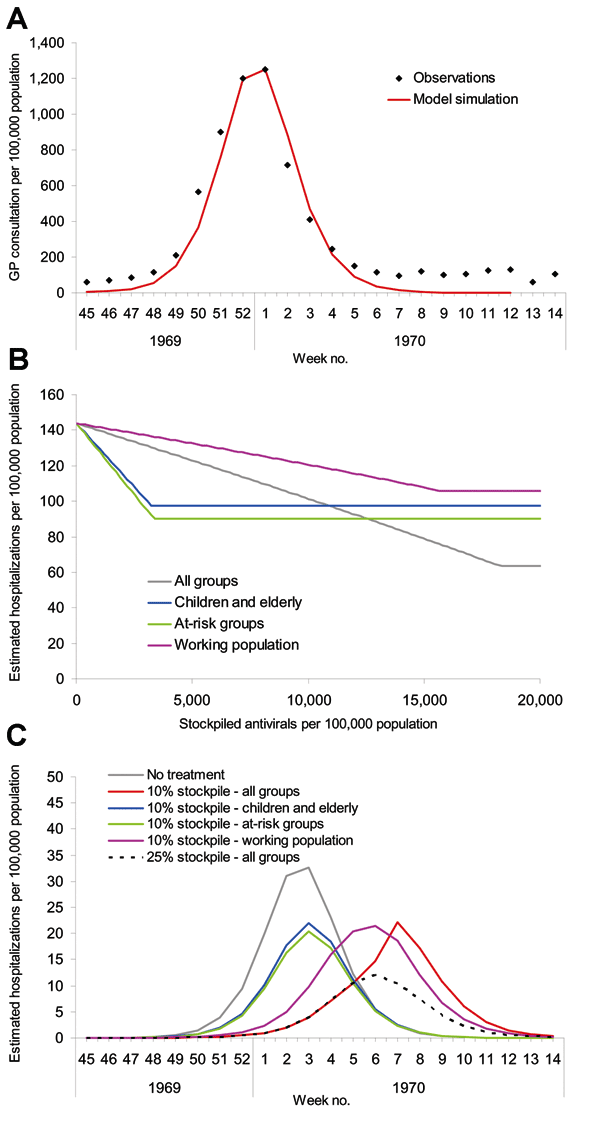Volume 11, Number 9—September 2005
Research
Potential Impact of Antiviral Drug Use during Influenza Pandemic
Figure 4

Figure 4. . A), Output from the model fitted to the second wave of the 1968 pandemic scaled to fit observations from general practitioners (GPs) from the 1968 pandemic (29). B), Estimated hospitalization rates from a simulated pandemic with available parameters from the 1968 pandemic as influenced by stockpile size and treatment strategy. C), Impact of treatment strategy on the time course of hospitalizations when the stockpile size is fixed at 10% of the population, the stockpile is fixed at 25% of the population and all clinical cases are treated, and when no treatment is administered.
References
- Johnson NP, Mueller J. Updating the accounts: global mortality of the 1918–1920 "Spanish" influenza pandemic.Bull Hist Med. 2002;76:105–15. DOIPubMedGoogle Scholar
- Nguyen-Van-Tam JS, Hampson AW. The epidemiology and clinical impact of pandemic influenza.Vaccine. 2003;21:1762–8. DOIPubMedGoogle Scholar
- World Health Organization. Influenza pandemic plan. The role of WHO and guidelines for national and regional planning. Geneva: The Organization; 1999.
- Patriarca PA, Cox NJ. Influenza pandemic preparedness plan for the United States.J Infect Dis. 1997;176(Suppl 1):S4–7. DOIPubMedGoogle Scholar
- UK Department of Health. UK pandemic influenza contingency plan. March 2005 [cited 2005 Mar 1]. Available from http://www.dh.gov.uk/assetRoot/04/10/44/37/04104437.pdf
- Fock R, Bergmann H, Bußmann H, Fell G, Finke E-J, Koch U, Influenza pandemic: preparedness planning in Germany.Eurosurveillance.2002;7:1–5.PubMedGoogle Scholar
- Health Canada. Canadian Pandemic Influenza Plan, Health Canada; 2004. [cited 2005 Mar 1]. Available from http://www.phac-aspc.gc.ca/cpip-pclcpi/
- Webby RJ, Webster RG. Are we ready for pandemic influenza?Science. 2003;302:1519–22. DOIPubMedGoogle Scholar
- Fedson DS. Pandemic influenza and the global vaccine supply.Clin Infect Dis. 2003;36:1552–61. DOIPubMedGoogle Scholar
- Pang X, Zu Z, Xu F, Guo J, Gong X, Liu D, Evaluation of control measures implemented in the severe acute respiratory syndrome outbreak in Beijing, 2003.JAMA. 2003;290:3215–21. DOIPubMedGoogle Scholar
- Wainright PO, Perdue ML, Brugh M, Beard CW. Amantadine resistance among hemagglutinin subtype 5 strains of avian influenza virus.Avian Dis. 1991;35:31–9. DOIPubMedGoogle Scholar
- National Institute for Clinical Excellence. Full guidance on the use of zanamivir, National Institute for Clinical Excellence. Full guidance on the use of zanamivir, oseltamivir and amantadine for the treatment of influenza. Available from http://www.nice.org.uk/pdf/58_Flu_fullguidance.pdf (2005)
- Kiso M, Mitamura K, Sakai-Tagawa Y, Shiraishi K, Kawakami C, Kimura K, Resistant influenza A viruses in children treated with oseltamivir: descriptive study.Lancet. 2004;364:759–65. DOIPubMedGoogle Scholar
- McKimm-Breschkin J, Trivedi T, Hampson A, Hay A, Klimov A, Tashiro M, Neuraminidase sequence analysis and susceptibilities of influenza virus clinical isolates to zanamivir and oseltamivir.Antimicrob Agents Chemother. 2003;47:2264–72. DOIPubMedGoogle Scholar
- Balicer RD, Huerta M, Grotto I. Tackling the next influenza pandemic.BMJ. 2004;328:1391–2. DOIPubMedGoogle Scholar
- Nguyen-Van-Tam JS, Leach SA, Cooper B, Gani R, Goddard NJ, Watson JM, Tackling the next influenza pandemic: ring prophylaxis may prove useful early on, but is unlikely to be effective or practical to implement once the pandemic is established. BMJ. B 22 July 2004]. [Cited 2005 Mar 1]. Available from http://bmj.bmjjournals.com/cgi/eletters/328/7453/1391#68042
- Meltzer MI, Cox NJ, Fukuda K. The economic impact of pandemic influenza in the United States: priorities for intervention.Emerg Infect Dis. 1999;5:659–71. DOIPubMedGoogle Scholar
- Longini IM, Halloran ME, Nizam A, Yang Y. Containing pandemic influenza with antiviral agents.Am J Epidemiol. 2004;159:623–33. DOIPubMedGoogle Scholar
- van Genugten ML, Heijnen ML, Jager JC. Pandemic influenza and healthcare demand in the Netherlands: scenario analysis.Emerg Infect Dis. 2003;9:531–8. DOIPubMedGoogle Scholar
- Cauchemez S, Carrat F, Viboud C, Valleron AJ, Boelle PY. A Bayesian MCMC approach to study transmission of influenza: application to household longitudinal data.Stat Med. 2004;23:3469–87. DOIPubMedGoogle Scholar
- Fleming D, Charlton J, McCormick A. The population at risk in relation to influenza immunisation policy in England and Wales.Health Trends. 1997;29:42–7.
- Department of Health. Influenza immunisation. CMO's update. 1997. [cited 2005 Mar 1]. Available from http://www.dh.gov.uk/assetRoot/04/01/35/74/04013574.pdf
- Monto AS. Influenza: quantifying morbidity and mortality.Am J Med. 1987;82:20–6. DOIPubMedGoogle Scholar
- Mann PG, Pereira MS, Smith JW, Hart RJ, Williams WO. A five-year study of influenza in families. Joint Public Health Laboratory Service/Royal College of General Practitioners Working Group.J Hyg (Lond). 1981;87:191–200. DOIPubMedGoogle Scholar
- The influenza epidemic in England and Wales 1957–58. Reports on public health and medical subjects no. 100. London: Her Majesty's Stationary Office; 1960.
- Taylor MP. Influenza 1968–1970 incidence in general practice based on a population survey.J R Coll Gen Pract. 1971;21:17–22.PubMedGoogle Scholar
- Reports on public health and medical subjects no. 4: report on the pandemic of influenza 1918–19. London: Her Majesty's Stationary Office; 1920.
- Barker WH, Mullooly JP. Impact of epidemic type A influenza in a defined adult population.Am J Epidemiol. 1980;112:798–811.PubMedGoogle Scholar
- Mills CE, Robins JM, Lipsitch M. Transmissibility of 1918 pandemic influenza.Nature. 2004;432:904–6. DOIPubMedGoogle Scholar
- Kermack WO, McKendrick AG. A contribution to the mathematical theory of epidemics. Proceedings of the Royal Society A: Mathematical, Physical and Engineering Sciences. 1927 Series A;115:700–21.
- Rvachev LA, Longini IM. A mathematical model for the global spread of influenza.Math Biosci. 1985;75:3–22. DOIGoogle Scholar
- Flahault A, Letrait S, Blin P, Hazout S, Menares J, Valleron AJ. Modelling the 1985 influenza epidemic in France.Stat Med. 1988;7:1147–55. DOIPubMedGoogle Scholar
- Flahault A, Deguen S, Valleron AJ. A mathematical model for the European spread of influenza.Eur J Epidemiol. 1994;10:471–4. DOIPubMedGoogle Scholar
Page created: August 31, 2012
Page updated: August 31, 2012
Page reviewed: August 31, 2012
The conclusions, findings, and opinions expressed by authors contributing to this journal do not necessarily reflect the official position of the U.S. Department of Health and Human Services, the Public Health Service, the Centers for Disease Control and Prevention, or the authors' affiliated institutions. Use of trade names is for identification only and does not imply endorsement by any of the groups named above.